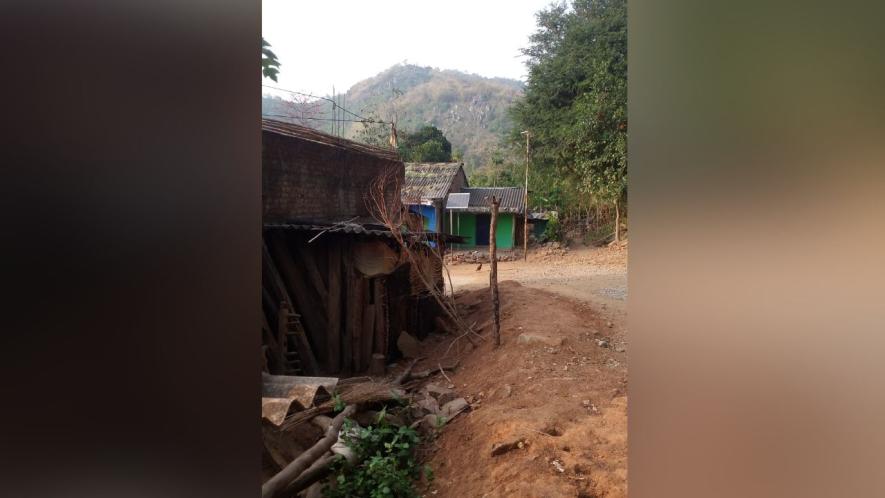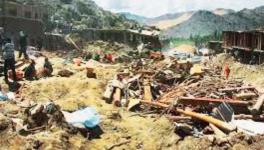Odisha: How a Village Became Self-Reliant by Tapping Hilltop Spring Water in Gajapati District

Pic of the mountain
This is a unique story of how self-sustenance of water flows down from the top of a mountain, serenading a large population of tribal villages down the hills, giving them new openings in life.
It was an arduous journey on a four-wheeler through the hilly tracks to reach a place called Samundokado in Gajapati district of Odisha, followed by an equally tough climb up a mountain that had changed many lives.
When we reached the peak of the mountain, things started unfolding, telling us what a pain must have been for the local inhabitants there to tame the hostile terrain and bring some change in their lives.
An Inspiring Tale
We were told an inspiring tale of self-sustenance in Samundokado village, where people had been craving for water for a few generations.
A non-descript village of over 32 households, Samundokado has a population of about 175. For years, water was a dream for these households. The women folk had to climb about 500 meters up to another small hillock to fetch headloads of water in pitchers for everything -- drinking, bathing and other requirements.
Sadly, the women had to go through this ordeal twice a day, rain or shine, for their basic needs. Given the situation, water for other things, such as growing crops, had remained like chasing a chimera till recent times.
They say that ‘faith can move mountains’, but in the case of Samundokado, it was just perseverance of the villagers and moral support from an organisation that made the mountain rain solace and sustenance, heralding a new dawn in the lives of the villagers.
With the expertise from Institute of Social Action and Research Activities (ISARA), the people of Samundokad were able to conquer the peak from where a natural water stream was flowing down waywardly and merging with a small rivulet in the wilderness.
People scaled up their energy to reach at the peak about 1,000 meters from the sea level, from where water was welling out, and tapped it through long pipes down the hills into an intake tank 50 meters above the village.
From a trickle to a gush, the water brought smiles on the faces of women and men of the village, who now enjoy the gurgling water flowing into the barren lands, slowly transforming them for cultivation and self-reliance.
“We faced a lot of problems. It was so difficult to climb up a hillock nearby to extract water from a small aquifer, take a bath there and then climb down with pitchers of waters on our heads and shoulders”, Vedika, a village woman, told NewsClick, adding “but now we are much relieved as the water has reached our doorsteps”.
The villagers belong to a tribal community and follow their conventional practices. Samundokado is located 110 kilometers from Ganjam district headquarter Paralakhemundi and 48 km from the block headquarters. There are 32 total households in the village, with a total population of around 176, of which 86 are male and 90 females.
ISARA has played the role of a major motivator to encourage the villagers, who till recent times were migrating to other states.
“We are just facilitators. The daunting task was how to motivate the villagers, both males and females, to take up the challenge for self-reliance. The spring water from the mountain top could be tapped through a simple technique which, although appears easy, requires a lot of hard work,” Rabindra Nath Patra, secretary of ISARA, told this writer.
He explained that once the spring water from the mountain was sourced through pipes and stored in the intake well, several outlet pipes at the bottom released water into several areas that were completely scorched. The results were visibly encouraging, he added.
What is noteworthy is that now the villagers themselves undertake water management etc., and buy pipes themselves for expansion of water distribution or irrigation. Rain or shine, nature is now within their control as long as the stream from the mountain top flows down.
The lush green look that the village has now, speaks volumes about a “revolution in the making” by the people of Samundokoda and Guruda.
The spring water harvesting system here covers two villages -- Guruda and Samundokado. The total length of the distribution pipeline is 1,500 meters.
It has to be seen to believe that the area covered through the spring water harvesting system is as vast as to accommodate sowing of crops in 40 acres each during Kharif and Rabi seasons. This area reduces in the summer season to 15 acres.
The villages produce vegetables, paddy, millets, cereal and other products, including organically grown ‘papaya’ and jackfruit, which are their unique selling point in the local markets, too.
One but appreciate the uphill task undertaken by the motivators like ISARA and the villagers. The story of spring water harvesting is not limited to Samundokoda or Guruda. There are 31 such spring water harvesting initiatives across Gajapati district, which have changed the lives of the people who otherwise were going out to other states as migrant labourers.
“Migration has nearly stopped, except in rare cases. Now, we do not go out to work as we have everything -- from Kharif to Rabi crops and many other products that fetch us money for our needs”, Sevati, a woman from Samundokado, said.
There were times when open defecation was common in these areas, but with water supply from mountain tops now becoming perennial, many households have constructed toilets and bathrooms with their own efforts, which is a turning point in their lives.
“Under Swachh Bharat scheme, although the NDA (National Democratic Alliance) government had promised a package of Rs 12,000 once toilets are built, but so far not a penny has come to us”, Anam, a frustrated villager from Guruda, said.
This initiative by ISARA seems to have made a big difference in over 30 villages in Gajapati district, benefitting over 6,000 population, where over 900 acres of Kharif crops are grown during the summer, while Rabi crops are lower at 300 acres.
The writer is a freelancer based in Odisha.
Get the latest reports & analysis with people's perspective on Protests, movements & deep analytical videos, discussions of the current affairs in your Telegram app. Subscribe to NewsClick's Telegram channel & get Real-Time updates on stories, as they get published on our website.
























